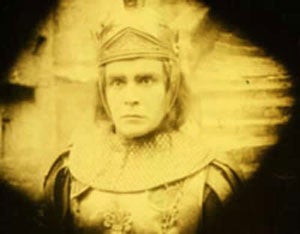Since its founding in 1994, the San Francisco Silent Film Festival has become the most important event of its kind in the United States. This was my first time, and I was certainly impressed with the incredibly enthusiastic audiences, audiences we can only dream of in Los Angeles. I was invited to attend because UCLA Film & Television Archive received the Silent Film Festival Award after the screening of The Goose Woman (1925) for its preservation work. My thanks go to Robert Byrne, Anita Monga and Stacy Wisnia, who were magnificent hosts.

The long weekend began with a reception at the home of Judy Wyler Sheldon, who is on the SFSFF Board of Directors (she's also the daughter of William Wyler, who bought the house in the 1970s). Speaking of boards, I was very impressed with the commitment of the Festival’s entire Board, which not only sponsored individual events, but seemed to be at almost every screening. That kind of commitment is priceless.
Thursday evening, the Festival proper at the Castro Theatre opened with John Ford’s Upstream (1927), recently discovered in New Zealand and preserved by the National Film Preservation Foundation. With cheap sets and no name actors, the film is a nice little B programmer about a boarding house full of actors and entertainers. Most similar to mature Ford may be the film's emphasis on ensemble acting rather than leads.
Friday morning at the Castro a surprising number of people showed up for “Amazing Tales From the Archives: The Archivist as Detective,” which included presentations by last year’s SFSFF preservation intern Ken Fox on making new titles for Douglas Fairbanks’ Mr. Fix-It (1918), my own PowerPoint lecture on identifying The Fall of Jerusalem (1922), as well as Anthony L’Abbate (George Eastman House) and Melissa Levesque (Academy Film Archive) on identifying nitrate film.

In the afternoon and evening, the Festival screened William Desmond Taylor’s Huckleberry Finn (1920), a sequel to the soon-to-be murdered director’s Tom Sawyer (1917). A previously lost film, Huckleberry Finn was a bit too sweet for my taste, given Twain’s unsentimental novel.
Seeing Yasujiro Ozu’s I Was Born, But… (1932) again confirmed for me its status as an a undisputed masterpiece of understatement, extremely modern in its observation of the mundane life of lower-middle class Japanese office workers and their families.
George Ponting’s The Great White Silence (1924), about Captain Robert Scott’s ill-fated march to the South Pole, confirmed my suspicions, articulated in my last blog from the "Screen" Conference that the British Film Institute’s color scheme was produced in the interest of DVD sales, rather than historical accuracy. It was candy-colored in a way that Anglo-American films seldom were by the mid-1920s; however, much of the footage—from original nitrate negatives—was breathtakingly rich in its details, and Sweden’s Matti Bye Ensemble delivered an amazing and ethereal accompaniment. Giovanni Pastrone’s Il Fuoco (1915) closed the night: an absolutely over-the-top melodrama about a man-eating vamp, starring Italian diva Pina Minichelli.
Saturday morning began with a couple of previously considered lost Walt Disney “Laugh-O-Grams” from the Museum of Modern Art, then transitioned to a panel of silent film composers and musicians tearing each other to pieces on stage over whose music was more or less historically accurate and whether it is even allowable to compose modern music scores for silent films. One well-known organist insisted that new music should only be composed for new silent films. Nevertheless, one must say the musical accompaniment by Donald Sosin, Stephen Horne, Dennis James, Alloy Orchestra and Matti Bye Ensemble all weekend long was uniformly excellent.

My personal revelation on Saturday was Mauritz Stiller’s The Blizzard (1923), starring Einar Hanson. Made a year before the director’s Gösta Berlings saga, the film demonstrates that there is still much to be discovered in Stiller’s Swedish work. Like other Swedish films from the period it has an incredible feel for nature, especially the brutal winter storm and reindeer stampede that is the film’s set piece.
UCLA Film & Television Archive’s preservation of The Goose Woman was also a big hit with the audience, due in no small part to Louise Dresser’s amazing performance as an alcoholic former opera star. That was followed by Mr. Fix-It, a totally manic Douglas Fairbanks comedy in which the hero turns some stuffed shirts inside out; it features a lengthy, red-light district rescue that fails because the hero’s girl was never in danger in the first place.
I would have loved to stay another day to watch Mikhail Kalatozov’s The Nail in the Boot (1932), and rewatch Lois Weber’s Shoes (1916) and Victor Seastrom’s He Who Gets Slapped (1924) with Lon Chaney, but other commitments pulled me back to L.A. But we know silent film is alive and well in San Francisco.






 Mobile Navigation
Mobile Navigation

